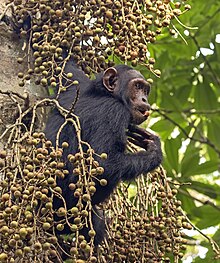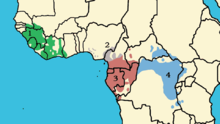
Back Sjimpansee Afrikaans Pan troglodytes AN شمبانزي شائع Arabic شيمبانزى شائع ARZ Zegol (Pan troglodytes) AVK Adi şimpanze Azerbaijani Обикновено шимпанзе Bulgarian Chimpanze boutin Breton Ximpanzé comú Catalan Pan troglodytes CEB
| Pan troglodytes[1] Temporal range: 4–0 mya[2]
| |
|---|---|

| |
| P. t. schweinfurthii in Kibale National Park, Uganda | |
| Scientific classification | |
| Domain: | Eukaryota |
| Kingdom: | Animalia |
| Phylum: | Chordata |
| Class: | Mammalia |
| Order: | Primates |
| Suborder: | Haplorhini |
| Infraorder: | Simiiformes |
| Family: | Hominidae |
| Subfamily: | Homininae |
| Tribe: | Hominini |
| Genus: | Pan |
| Species: | P. troglodytes
|
| Binomial name | |
| Pan troglodytes (Blumenbach, 1775)
| |
| Subspecies | |

| |
Distribution of subspecies
| |
| Synonyms | |
| |
The chimpanzee (Pan troglodytes), or robust chimpanzee, is a species of great ape. The common chimpanzee is often called the chimpanzee (or "chimp"), but this can refer to both species in the genus Pan: the common chimpanzee and the closely related bonobo.
Evidence from fossils and DNA sequencing show both species of chimpanzees are the closest living relatives to modern humans.
The common chimpanzee is more robust than the bonobo, weighing between 40 and 65 kg (88 and 143 lb) and measuring approximately 1.3 to 1.6 m (4 ft 3 in to 5 ft 3 in). Its gestation period is eight months. The infant is weaned at about three years old, but usually maintains a close relationship with its mother for several more years; it reaches puberty at the age of eight to 10, and its lifespan in captivity is about 50 years.
The common chimpanzee lives in groups which range from 15 to 150 members, although individuals travel and forage in much smaller groups during the day. The species lives in a male-dominated strict hierarchy. Disputes can generally be settled without the need for violence.
Nearly all chimpanzee populations have been seen using tools, modifying sticks, rocks, grass, and leaves. They use them for getting honey, termites, ants, nuts, and water. The species has also been seen making sharpened sticks to spear Senegal bushbabies out of small holes in trees. So although it is mainly a herbivore, it does eat other animals to some extent.
The common chimpanzee is listed on the IUCN Red List as an endangered species. There are between 170,000 and 300,000 individuals. They live in the forests and savannahs of West and Central Africa. The biggest threats to the common chimpanzee are habitat destruction, poaching and disease.
- ↑ Groves, Colin (2005). Wilson, D. E.; Reeder, D. M. (eds.). Mammal Species of the World (3rd ed.). Johns Hopkins University Press. p. 183. ISBN 0-801-88221-4.
- ↑ McBrearty, Sally; Jablonski, Nina G. (2005). "First fossil chimpanzee". Nature. 437 (7055): 105–108. Bibcode:2005Natur.437..105M. doi:10.1038/nature04008. ISSN 0028-0836. PMID 16136135. S2CID 4423286.
- ↑ Humle, T.; Maisels, F.; Oates, J.F.; Plumptre, A.; Williamson, E.A. (2016). "Pan troglodytes (errata version published in 2018)". IUCN Red List of Threatened Species. 2016: e.T15933A129038584.
